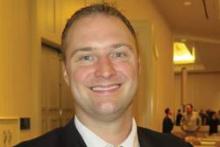CORONADO, CALIF. – Major outcomes of stroke, myocardial infarction, and 30-day mortality following carotid stenting are nearly equivalent between surgeons and interventionalists, results from a national cohort study suggest.
In addition, the volume of cases performed by a clinician, rather than the clinician’s specialty, appears to be a stronger predictor of adverse outcomes for performing carotid stenting. Those are key findings from an evaluation of more than 20,000 carotid stenting procedures extracted from the Nationwide Inpatient Sample (NIS) between 2004 and 2011, which was presented at the annual meeting of the Western Vascular Society.
“Stroke is the third most common cause of death in the United States, and 20%-25% of strokes are attributable to carotid stenosis,” said lead author Dr. Michael D. Sgroi, of the division of vascular and endovascular surgery at the University of California, Irvine. “The current standard of care has been carotid endarterectomy. However, in 2010, carotid stenting was recognized as an alternative treatment. Since that time, there’s been an exhaustive debate regarding which is the best treatment.
“In addition, there has been a broad spectrum of physicians practicing the use of carotid stenting, including vascular surgeons, interventional radiologists, neurovascular interventionalists, and interventional cardiologists. This begs the question: Does specialty make a difference in outcomes for carotid stenting?”
Dr. Sgroi and his associates evaluated 20,663 carotid stenting procedures extracted from the NIS dataset. They divided the cohort based on the type of provider performing the procedure: surgeon or interventionalist. All elective, urgent, and emergent cases of carotid stenting were included in the analysis, while patients who underwent balloon angioplasty were excluded, as were those who underwent carotid endarterectomy. The primary endpoints were postoperative stroke or myocardial infarction (MI) and in-hospital mortality. The secondary endpoint was estimated associations with a 10-unit volume difference among centers.
Upon first glance at the data, the researchers detected low numbers of interventionalists. Therefore, they created criteria to identify physicians who were considered surgeons. They defined a surgeon as a physician who performed a carotid endarterectomy and either a femoral-popliteal artery bypass or an arteriovenous fistula within the same calendar year of the carotid stenting procedure.


